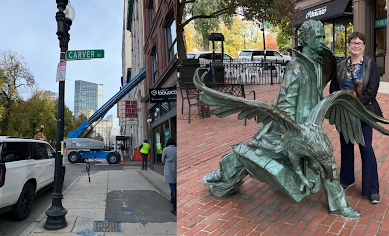Poetry is a great example of authentic writing because poetry is meant to be shared. Poems can be used to entertain and may be displayed on classroom walls and halls. They may easily be slipped into a letter to a relative or friend and be given as a gift. Interesting words may even be printed on magnets and hung on refrigerators to inspire family members to create spontaneous lines of poetry.
This month I'm sharing a fun poetry-writing activity based on my new decodable book, The Box. Read my recent post HERE to learn more about the story, my process for creating decodable books, and list poems in general. The Box is on sale for $8.99 for the month of April on Amazon. Watch for the black-and-white chapter book version for older students, Gods and Gifts, coming this summer. It includes the first three books of the series reconfigured as chapters telling the Greek Creation Story.
Now back to Pandora... Imagine that Pandora's Box was a lunch box. What kind of disgusting things might have come out of it? What is something good that might have been left at the bottom? A link to the Free Activity PDF may be found at the bottom of this post.
Directions: Start by brainstorming lists of disgusting foods with your students like moldy meatballs, soggy sandwiches, and squishy squid soup. The PDF includes one blank chart and one that already has a few suggestions. Choose whichever one works best for your students.
You may want to focus on word patterns you are studying in class such as consonant-L-silent e (CLe) words like maple, waffle, and apple. Speech-language pathologists might have their students choose words that start with the /r/ sound like rice with lice, bologna rigatoni, and rabbit foot stew or /s/ like spicy spinach spam.
1. Help students brainstorm a list of disgusting foods and write them on the graphic organizer in the PDF.
2. Write down one delicious food at the bottom of the graphic organizer.
3. Draw a lunch box, use plain brown lunch sacks, or use the lunchbox graphic in the PDF.
4. Write this phrase at the top of the box or sack - Pandora opened her lunch box and out came disgusting things like...
5. Cut out 3 disgusting foods and glue them underneath.
6. Write this phrase near the bottom - Pandora was about to slam her lunch box shut when a little voice said, "No, don't leave me inside, I'm...
7. Cut out the last delicious food item and glue it at the bottom.
Here are some examples from the downloadable PDF:
Get the Free Activity PDF HERE. Sign up for my newsletter HERE and receive a free copy of my first decodable book, No Gift for Man. Don't miss any of the fun-filled activities I'm creating for A Year of AWE: Authentic Writing Experiences.
%20(5)%20copy.png)




.png)


.png)






.png)





%20(4).png)




%20(1).png)

%20(1%20x%203%20in)%20(3%20x%201%20in)%20(3%20x%200.8%20in).png)
%20(1).png)





.png)

